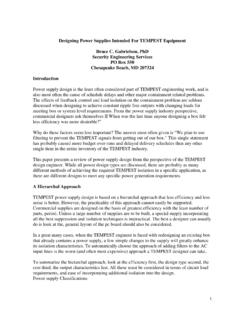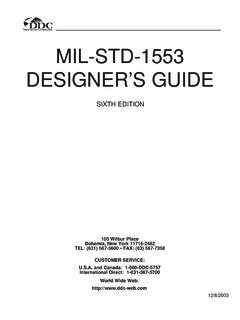Transcription of Power/Ground Isolation and Control in Facilities, Systems ...
1 1 Power/Ground Isolation and Control in facilities , Systems , and in System Boxes Bruce C. Gabrielson, PhD Security Engineering Services 5005 Bayside Road Chesapeake Beach, Maryland 20732 Introduction ground Isolation between power Systems and communication Systems at either the box or system level is the primary protective barrier between a secure and a non-secure environment. At the macro level, facilities which process Command, Control , Communications, and/or Intelligence information are usually required to provide some level of security protection, often including RED/BLACK (COMSEC) and TEMPEST protection, for classified data transfers. Typically, these facilities have been built to a variety of building codes that either directly dictate the grounding and bonding employed or indirectly restrict what can be done to enhance the facilities secure processing capabilities. At the system level, secure conducted emission Isolation can not take place unless proper separation of the various system parts is maintained.
2 This Isolation at the system level is difficult to achieve unless the facility allows separate controlled power and ground Systems to exist. At the micro level, various circuit nets also must maintain their own isolated power , signal return, and box ground Control . Isolation at this level is also difficult to maintain, since often ground and power controls are circumvented due to radiated emissions and capacitive coupling paths not so readily identified as they would be at the macro level. Not only is isolated ground Control for secure hardware a problem, but, as in the case of platforms, other EM related effects such as lightning, EMC, and EMP protection, plus their associated grounding and bonding requirements, can directly alter the ability of secure emission suppression techniques to function properly. In addition, emission problems that couple into the power system and then re-radiate through the extended antenna system these wires create is also a problem.
3 As an example of interactive grounds at the facility level, the practices set forth in the National Electrical Code 1984 (NFPA 70)1 issued by the National Fire Protection Association Control only the electrical fault protection ground network, and is not effective, nor does it address the elimination of ground loops in communication Systems . Guidelines for protecting facilities that 1 National Electrical Code 1984, NFPA 70-1984, National Fire Protection Association, Quincy, MA, 1983. 2process TEMPEST controlled signals are incorporated into NACSIM 52032, or Military Handbook (MIL-HDBK) 2323. Since the interconnection of secure data processing equipment within a facility is a system or platform level problem, solutions must first be tailored within the overall context of the system itself. Therefore, an initial examination of the problem from the macro level is essential.
4 This paper deals first with generic grounding and power system problems and recommended solutions at the facility level, then the system level, and then finally at the box level. Both what should be done and what can practically be done to eliminate security problems in most cases are investigated. Practical Grounding Specifics Figure 1 shows the four possible grounding configurations for a communications system. Figure 2 shows the practical grounding configurations for signal distribution at the system level. Regardless of their application at the box, system, or facility level, some combination of these grounds is nearly always present. Various ground conditions are employed to Control common mode or differential mode noise paths. The term differential mode (balanced or transverse mode) describes signals that are sent out over and return back over another wire (or conductive path).
5 For this case neither wire is grounded. An example would be a transformer coupled MIL-STD-1553 data buss. For differential mode transmissions, when the signal on one wire goes up by +V, the signal on the opposite wire goes down by -V with respect to ground . Figure 3 describes common and differential mode voltage potentials. In general, it is very difficult to accurately predict the antenna effects or signal current distribution of unprotected interconnect cabling. However, two criteria can be used which will identify the potential for a TEMPEST radiated problem's existence. If interconnecting cables are more than 10% the length of the wavelength of the signals carried (or any coupled signals which 2(U) NACSIM 5203, Guidelines for Facility Design and RED/BLACK Installation, NSA, 30 June 1982, (C). 3 MIL-HDBK-232, Military Standardization Handbook, Red/Black Engineering-Installation Guidelines, DOD, 14 November 1972.)
6 3might also be present), the potential for a radiated problem exists. The wavelength of a 100 KHz signal is 3000 meters in air. Therefore, Isolation problems should exist primarily at large facilities . One way to protect from cable radiation problems is with shielding. Shields work to the advantage of the designer if they attenuate the inner radiated signals and to the designers disadvantage if they conduct protected signals and otherwise defeat the controlled ground system. For effective shielding, the shields must be greater than skin depth thick compared to the signals being carried. Skin depth indicates how far an electromagnetic field can penetrate a conductor before its amplitude is reduced to 37 percent of what it was at one surface. Since most cable shields are less than a skin depth thick, substantial leakage can occur directly through the shield. The formula for skin depth is provided below.
7 Where e is the resistivity of the metal in ohm-cm r is the permeability of the metal relative to air f is the frequency in MHz As stated, controlling the radiated signal is sufficient provided common mode or differential mode conducted emission problems are not enhanced by cable shield connections that defeat the facility ground system as shown in Figures 4 and 5. f/5 = r 4between two parts of a system as a result of other ground controls such as fault protection can also result in the protected signals modulating ground noise and then conducting the composite signal between various boxes in the system. This subject will be addressed in the next section. Facility Isolation A complete facility with secure processing capabilities is shown in Figure 6. While various documents, such as MIL Handbook 232, NACSEM 5109, NACSEM 5111, and NACSEM 5203, and DIAM 50-3 provide guidance and verification criteria for various controlled access secure facilities applications, it still falls upon the engineer responsible to determine the unique techniques and application of principles to be employed at each individual location.
8 Not only must the specific EM discipline be considered, but all the various inter-related EM problems must also be considered. Shielded rooms are commonly used for secure SCIFs and for test chambers. The facility shielding is used to prevent disruptive or compromising coupling of electromagnetic energy between internal equipment and the external environment. Rooms are shielded using conductive paint, foil, or steel sheets. To maintain the shielding integrity of these EM barriers, all seams must be made electrically tight and all penetrations must be constructed and maintained to prevent unintended coupling of energy through the barrier. These penetrations include those required for personnel access, HVAC support, and signal and power transmission. For maximum shielded steel type enclosures, isolated power and ground connections are fully implemented. Shown in Figure 6 is an isolated power and ground system using filters and an Isolation transformer.
9 Notice the local room ground and the isolated case for the Isolation transformer. Room grounding is often accomplished by driving a copper bar through the building 5foundation and well into the ground beneath. Another method is to use a bar emerged in a well filled with salt water (salt pit ground ). For safety reasons, Isolation transformers usually have their case grounded. ground Isolation from the facility can then be achieved by using a plastic spacer in the conduit between the room and transformer. Additional information on Earth grounding is included later in this paper. EQUIPMENT RA DIA TION TEMPEST Z ONE ( ETRZ ) 6 For underground facilities , the housing typically consists of large interconnected metal rooms. The rock and earth overburden provides some degree of attenuation to EM energy; however, for complete EMP and TEMPEST/COMSEC protection, the added metal enclosures are necessary.
10 The C3I facilities associated with the generation and transmission of high power radio frequency (RF) signals ( , long range radar installations or those providing high satellite linkages) commonly incorporate continuous RF shielding to Control EMI to internal equipment. Similar requirements also exist in those facilities near commercial broadcast facilities or other RF-generating sources. Steel structural members offer many parallel conducting paths between various points within the facility and between these points and earth. These structural building support members are frequently in direct contact with soil and can provide a low impedance path to earth. Because of the large cross sectional areas of steel super-structural members, the net impedance between points is frequently less than that provided by lightning down conductors and electrical grounding conductors. For this reason, crossbonding between lightning down conductors and structural members is required to Control flashover.


